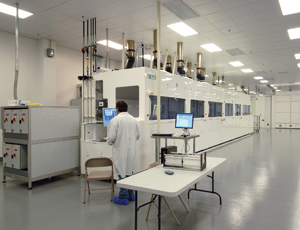The industrial and manufacturing sector, already care-worn with decades of ‘hollowing out’ as plants moved overseas, continued its slow spiral downward in the last year. The economic crisis that hit in fall 2008 further sapped capital expenditures across the board, and the bankruptcy of two of America’s Big Three automakers this spring contributed to the decline.


There are some bright spots, however. New starts have ramped up for polysilicon manufacturing plants as demand for photovoltaics increases and the demand for new battery technology to power hybrid vehicles has created a mini-boom in battery plants in the U. S. A recent injection of accelerated tax credits for plant and equipment for alternative-energy manufacturing, announced by the Obama administration in August, should provide even more stimulus for that sector.
Still, the short-term outlook is one of reduced capacity, more emphasis on retrofits instead of new plant construction, and a sector hamstrung by a lack of credit and slack consumer demand, sources say. “There is a pall of uncertainty hanging over everything,” says Richard Haller, CEO of Detroit-based Walbridge. “The arc of the manufacturing sector, if you want to call it an arc, is more a hyperbolic curve downward.”
Key manufacturing sectors like auto and steel production were doing well enough last year, Haller says, with work on the boards, particularly plans for retrofits to adapt to new types of demand. “Then August hit,” he says, referring to the global economic meltdown. “Then everything just stopped. It just really decimated manufacturing,” he says.
The resulting lack of credit has stalled projects and led to what Haller says is a major reduction in capital construction spending in those sectors. Other major contractors agree. “Certainly, we have seen a marked decline in the last 12 months in demand for construction in the manufacturing sector,” says Gavin Keith, project executive for DPR Construction, San Jose, Calif. “The collapse of access to capital/financing, the low demand for products and the uncertainty of the timing for recovery, have all stifled manufacturing production and ensuing capital construction programs.”
DPR says its best growth potential is in computer-chip fabrication plants, battery plants and solar-panel manufacturing. One example is a new solar-cell plant manufacturing facility in Norcross, Ga, built for Suniva Inc. The 45,000-sq-ft design-build facility—one of the first of its kind in the U.S.—was completed in 16 weeks earlier this year and includes advanced elements such as high-purity water systems, onsite waste-treatment systems, chemical-delivery systems, chemical bunker and high-purity piping.
Solar-panel manufacturing is quite hot, say industry sources. The Houston-based research firm Industrial Info Resources Inc., estimates there are at least 12 such facilities under development but not yet under construction in the U.S., totaling $780 million. The largest currently under way is a $210-million facility near Austin, Texas, by Austin-based Solar Array Ventures. The project broke ground in June. DPR Construction is lead contractor on the plant.
Not Gloomy
“It is not all gloom and doom out there,” says Michael Bergen, vice president of marketing with Industrial Info Resources. There are roughly $10 billion of semiconductor chip plants planned or under construction in the U.S. Intel, for example, is spending $3 billion to expand a chip plant in Chandler Ariz. Another similarly sized expansion is under way at Intel’s existing plant in New Mexico.
Global Foundries Inc., Sunnyvale, Calif., began site preparation earlier this year for a new $4.2-billion greenfield semiconductor manufacturing plant in Saratoga Springs, N.Y. Delaney Construction Corp., Mayfield, N.Y., is providing civil/site prep for the project.
The downturn is changing how semiconductor plant owners engage contractors, says Bart Eberwein, CEO of Hoffman Co., Portland Ore. With less work and more hungry contractors, owners are squeezing every penny from their supply chain. “We’re seeing a shift in purchasing strategy,” says Eberwein. “It is becoming super-cost driven.”
Some manufacturers are even moving away from preferred providers, Eberwein says. “They are saying, ‘This is going to be all about costs, this is all about fees.’” Hoffman has seen a 30% drop in manufacturing...

Post a comment to this article
Report Abusive Comment